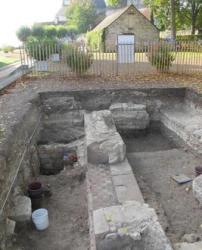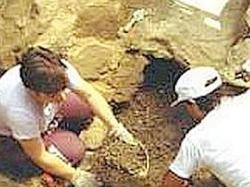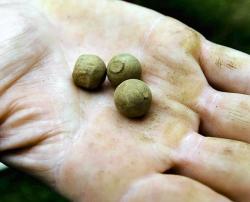INSTITUT SUPERIEUR D'ANTHROPOLOGIE
INSTITUTE OF ANTHROPOLOGY
ONLINE COURSES / COURS A DISTANCE
FALL TERM : OCTOBER 2013
REGISTER NOW
FRANCE –  Loches - Des fouilles se déroulent actuellement dans l'enceinte du Logis royal de Loches. D'ores et déjà, certaines choses sont connues, d'autres remontent à la surface grâce au chantier en cours. « Au travers de textes et de rares petits travaux archéologiques menés ici dans le passé, on sait que le site a été occupé avant la période romane, dès l'Antiquité et à partir du haut Moyen Age. « Il y avait notamment un castrum et deux églises : à partir du VIe siècle, la présence du pouvoir civil et du pouvoir religieux (NDLR : au sein de ce que l'on appelle aujourd'hui la cité royale) est attestée », indique Pierre Papin, responsable des sondages archéologiques conduits autour du Logis royal. Mais des traces plus anciennes encore ont été mises au jour dans les années 70 au sein du fort Saint-Ours, au pied du Logis. « Dans les fondations de l'ancienne église Saint-Ours, on a découvert des vestiges datant du IIe siècle après Jésus-Christ. Manifestement, il y avait là une agglomération antique dont on ne connaît strictement rien », poursuit le spécialiste.Le potentiel archéologique de la cité royale est donc immense. Le découvrir dans son intégralité demanderait beaucoup de temps. Et d'argent. Cet été, les archéologues ont notamment découvert des vestiges datant des VIIIe et IXe siècles sous le grand bâtiment d'époque romane (XIe siècle) qu'ils ont mis au jour au fond du parc du Logis royal.
Loches - Des fouilles se déroulent actuellement dans l'enceinte du Logis royal de Loches. D'ores et déjà, certaines choses sont connues, d'autres remontent à la surface grâce au chantier en cours. « Au travers de textes et de rares petits travaux archéologiques menés ici dans le passé, on sait que le site a été occupé avant la période romane, dès l'Antiquité et à partir du haut Moyen Age. « Il y avait notamment un castrum et deux églises : à partir du VIe siècle, la présence du pouvoir civil et du pouvoir religieux (NDLR : au sein de ce que l'on appelle aujourd'hui la cité royale) est attestée », indique Pierre Papin, responsable des sondages archéologiques conduits autour du Logis royal. Mais des traces plus anciennes encore ont été mises au jour dans les années 70 au sein du fort Saint-Ours, au pied du Logis. « Dans les fondations de l'ancienne église Saint-Ours, on a découvert des vestiges datant du IIe siècle après Jésus-Christ. Manifestement, il y avait là une agglomération antique dont on ne connaît strictement rien », poursuit le spécialiste.Le potentiel archéologique de la cité royale est donc immense. Le découvrir dans son intégralité demanderait beaucoup de temps. Et d'argent. Cet été, les archéologues ont notamment découvert des vestiges datant des VIIIe et IXe siècles sous le grand bâtiment d'époque romane (XIe siècle) qu'ils ont mis au jour au fond du parc du Logis royal.
http://www.lanouvellerepublique.fr/Indre-et-Loire/Loisirs/Patrimoine-tourisme/n/Contenus/Articles/2013/09/29/Qu-y-avait-il-avant-le-Logis-royal-1630801
ITALIE –  Viterbo - Archaeologists in central Italy have unearthed two female statuettes and other rare Etruscan artefacts dating from 2,500 years ago. The two bronze statuettes date from the fourth and fifth centuries BC were found inside a small shrine devoted to the ancient Godess of agriculture and religion, Demeter, near the city of Viterbo. Also found at the site was an Etruscan bronze incense burner and the lid of an ivory box decorated with a mermaid. Archaologists believe the objects were hastily buried in the shrine to protect them from destruction by advancing Roman soldiers. Lucio Fiorini from the University of Perugia and colleagues from the Southern Etruria Archaeological Superindendency uncovered the treasures during an annual dig.
Viterbo - Archaeologists in central Italy have unearthed two female statuettes and other rare Etruscan artefacts dating from 2,500 years ago. The two bronze statuettes date from the fourth and fifth centuries BC were found inside a small shrine devoted to the ancient Godess of agriculture and religion, Demeter, near the city of Viterbo. Also found at the site was an Etruscan bronze incense burner and the lid of an ivory box decorated with a mermaid. Archaologists believe the objects were hastily buried in the shrine to protect them from destruction by advancing Roman soldiers. Lucio Fiorini from the University of Perugia and colleagues from the Southern Etruria Archaeological Superindendency uncovered the treasures during an annual dig.
http://www.adnkronos.com/IGN/Aki/English/CultureAndMedia/Italy-Rare-Etruscan-treasures-uncovered-near-central-city-of-Viterbo_32670377095.html
TURQUIE –  Iasos - Archaeologists working on Iasos on Turkey’s Aegean coast have recently discovered that the ancient city was buried under a mountain of ash caused by the explosion of Mt. Thera on Santorini 3,600 years ago. Excavation works have also revealed a sewage system that was in place in the 4,000-year-old city and tunnels to the city’s theater. The head of the excavations, Professor Marcello Spanu said columns that were found one meter underground provided vital information about the history of the city. “Following the explosion of the volcano Thera, which also caused the destruction of the Minoan civilization on the islands of Crete and Santorini, the ancient city was covered with ash and remained so for a while. This is why its sewage system and tunnels to the ancient theater did not change. At the end of the excavation and restoration works, for which we spend nearly 100,000 Turkish Liras annually, I am sure that this place will be Turkey’s largest, as well as one of its most important, archeoparks,” Spanu said.
Iasos - Archaeologists working on Iasos on Turkey’s Aegean coast have recently discovered that the ancient city was buried under a mountain of ash caused by the explosion of Mt. Thera on Santorini 3,600 years ago. Excavation works have also revealed a sewage system that was in place in the 4,000-year-old city and tunnels to the city’s theater. The head of the excavations, Professor Marcello Spanu said columns that were found one meter underground provided vital information about the history of the city. “Following the explosion of the volcano Thera, which also caused the destruction of the Minoan civilization on the islands of Crete and Santorini, the ancient city was covered with ash and remained so for a while. This is why its sewage system and tunnels to the ancient theater did not change. At the end of the excavation and restoration works, for which we spend nearly 100,000 Turkish Liras annually, I am sure that this place will be Turkey’s largest, as well as one of its most important, archeoparks,” Spanu said.
http://www.hurriyetdailynews.com/ancient-city-of-iasos-rises-out-of-the-ashes.aspx?pageID=238&nID=55343&NewsCatID=375
FRANCE –  Bayeux - Le diagnostic réalisé sur un immeuble de la rue de la Juridiction, à deux pas de la cathédrale, avant des travaux importants, a permis de dater cet édifice. La maison érigée au XIIIe siècle serait l’une des plus vieilles de la ville. « Cette découverte est importante, assure Florian Bonhomme de l’Institut national de la recherche archéologique (Inrap). Elle est même relativement rare en Normandie. » Au début du mois, des études ont été menées sur un bâtiment de la rue de la Juridiction. « Un diagnostic demandé par le Service régional d’archéologie, avant une profonde modification de cet édifice et des travaux qui vont bientôt avoir lieu, à l’intérieur de ce bâtiment classé. » Une partie de cet édifice situé à l’arrière de la maison d’Adam et Ève date très probablement du XIIIe siècle. « Pour le moment, nous pouvons estimer qu’elle a été édifiée au XIIIe siècle, ce qui est plutôt rare en Normandie, souligne Florian Bonhomme. Cette étude sur le bâti est une nouveauté dans la région. Le premier diagnostic de ce type en Normandie a été mené à Bellême, dans l’Orne en juillet. »
Bayeux - Le diagnostic réalisé sur un immeuble de la rue de la Juridiction, à deux pas de la cathédrale, avant des travaux importants, a permis de dater cet édifice. La maison érigée au XIIIe siècle serait l’une des plus vieilles de la ville. « Cette découverte est importante, assure Florian Bonhomme de l’Institut national de la recherche archéologique (Inrap). Elle est même relativement rare en Normandie. » Au début du mois, des études ont été menées sur un bâtiment de la rue de la Juridiction. « Un diagnostic demandé par le Service régional d’archéologie, avant une profonde modification de cet édifice et des travaux qui vont bientôt avoir lieu, à l’intérieur de ce bâtiment classé. » Une partie de cet édifice situé à l’arrière de la maison d’Adam et Ève date très probablement du XIIIe siècle. « Pour le moment, nous pouvons estimer qu’elle a été édifiée au XIIIe siècle, ce qui est plutôt rare en Normandie, souligne Florian Bonhomme. Cette étude sur le bâti est une nouveauté dans la région. Le premier diagnostic de ce type en Normandie a été mené à Bellême, dans l’Orne en juillet. »
http://www.ouest-france.fr/ofdernmin_-Bayeux.-Les-archeologues-au-chevet-d-une-maison-du-XIIIe-siecle_40771-2232349-pere-bno_filDMA.Htm
USA –  Watrous Point - Archaeologists have found evidence of a shipwreck in the Connecticut River that could be linked to a 200-year-old battle in which the British set fire to 25 ships in Essex harbor, the largest maritime loss of the War of 1812. The wreck lies in several feet of water off Watrous Point, a mile south of Essex harbor, and is indicated by a "ballast pile," an oblong mound of stones that were once in the ship's hold for stability. The stones remained after the hull disintegrated. Under gray skies Friday, archaeologists from the University of Connecticut and the Mashantucket Pequot Research Center stood waist deep in the chilly river water removing hundreds of pounds of the ballast stone to the reach the hull beneath. Waves from passing boats jostled the crews as they struggled to keep their footing.
Watrous Point - Archaeologists have found evidence of a shipwreck in the Connecticut River that could be linked to a 200-year-old battle in which the British set fire to 25 ships in Essex harbor, the largest maritime loss of the War of 1812. The wreck lies in several feet of water off Watrous Point, a mile south of Essex harbor, and is indicated by a "ballast pile," an oblong mound of stones that were once in the ship's hold for stability. The stones remained after the hull disintegrated. Under gray skies Friday, archaeologists from the University of Connecticut and the Mashantucket Pequot Research Center stood waist deep in the chilly river water removing hundreds of pounds of the ballast stone to the reach the hull beneath. Waves from passing boats jostled the crews as they struggled to keep their footing.
http://www.courant.com/news/connecticut/hc-essex-shipwreck-0929-20130928,0,5183080.story